Se stai cercando il miglior software di gestione delle foto, allora questa è la guida che fa per te. Abbiamo testato e recensito tutti i migliori software di gestione delle foto oggi sul mercato per aiutarti a scegliere quello giusto per le tue esigenze.
Trovare un modo per gestire le tue foto può essere difficile, soprattutto quando ci sono così tante opzioni tra cui scegliere. Se hai migliaia di foto e desideri un buon modo per organizzarle e trovarle in un secondo momento, allora hai bisogno di un software di gestione delle foto.
Il software di gestione delle foto, chiamato anche sistemi di gestione delle risorse digitali (DAM), ti aiuta a organizzare le tue foto e archiviarle in un unico posto. Ti consente di trovare e condividere facilmente le tue foto, nonché di modificarle e migliorarle.
Abbiamo esaminato 11 dei migliori programmi software di gestione delle foto per scoprire quali vale la pena pagare, a partire dalla nostra prima scelta:Adobe Lightroom CC. Adobe Lightroom CC è il nostro programma software di gestione delle foto preferito perché ha tutto ciò di cui hai bisogno per organizzare le tue immagini e migliorarle utilizzando un'interfaccia intuitiva facile da usare anche per i principianti.
Miglior software di gestione delle foto – Introduzione
Nel corso degli anni, sono rimasto sbalordito da quanto si sia evoluta la fotografia digitale. Dalla prima fotocamera digitale che ho acquistato nel 1994 alle ultime fotocamere e smartphone DSLR, la qualità delle foto continua a migliorare.
Ricordo quando i megapixel erano di gran moda per i consumatori, ma ora la maggior parte dei fotografi professionisti scatta e stampa foto con meno di 10 megapixel. Allora cosa è cambiato? La qualità di sensori, obiettivi, software e potenza di elaborazione è migliorata in modi che ci consentono di acquisire più dettagli che mai.
Ho iniziato a scattare foto al liceo usando una fotocamera a pellicola e imparando a conoscere ISO, f-stop, velocità dell'otturatore e altri elementi che mi hanno aiutato a scattare foto migliori. Dopo aver frequentato un corso di fotografia al college, ho avuto la possibilità di scattare la mia prima foto digitale con una fotocamera Kodak DSC-550 dopo che il mio professore l'ha presa in prestito da un suo amico.
Sebbene la qualità dell'immagine non fosse eccezionale rispetto agli standard odierni (aveva solo 1,3 MP), sono rimasto sbalordito perché potevo vedere la foto immediatamente sullo schermo!
Qual è il miglior software di gestione delle foto?
Che tu sia un hobbista o un fotografo professionista, scattare foto è solo metà della battaglia. Devi trovare un modo per organizzare e gestire le tue foto una volta scattate.
Il software di gestione delle foto è progettato per questo scopo e, come può dirti chiunque abbia provato a organizzare migliaia di foto digitali, è essenziale. Il problema con il software di gestione delle foto è che ci sono così tante soluzioni là fuori che può essere difficile sapere quale sia la migliore.
Questo post ti guiderà attraverso le tue opzioni, spiegando i pro ei contro di ciascuna soluzione per aiutarti a prendere una decisione informata. Gestione delle foto Esistono due modi principali in cui il software di gestione delle foto organizza le immagini:per tipo di file o per album.
Entrambi i metodi hanno i loro pro e contro, ma la maggior parte delle persone ritiene che un approccio funzioni meglio per loro rispetto all'altro. La buona notizia è che la maggior parte dei programmi ti consente di scegliere tra i due approcci (o di utilizzarli entrambi contemporaneamente).
Software di gestione delle foto basato su album Questo tipo di software di gestione delle foto utilizza gli album come unità organizzativa di base:invece di singoli file o cartelle, le immagini vengono inserite in album diversi in base all'argomento, alla posizione o all'occasione. Quando visualizzi le tue foto, puoi visualizzare tutti gli album insieme in un'unica vista.
1. Adobe Lightroom
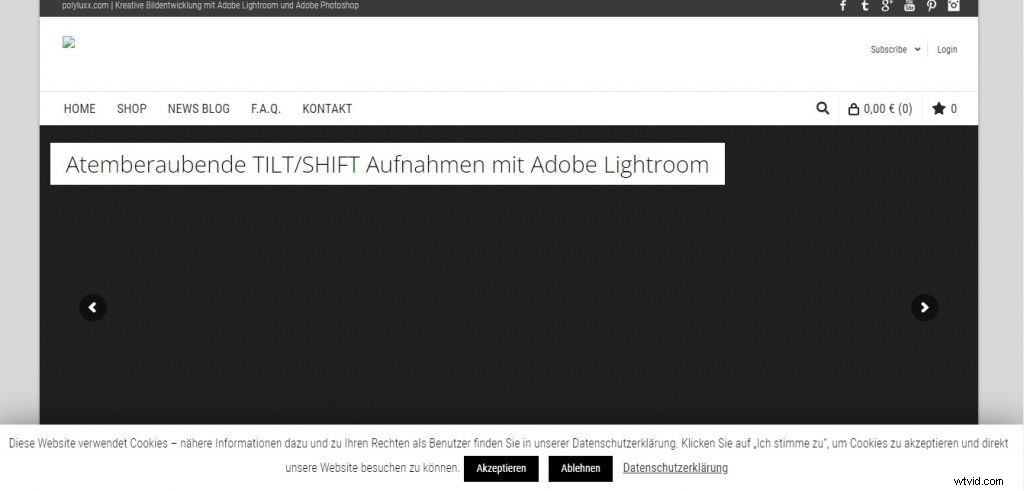
Adobe Lightroom è un programma di fotoritocco di base che ha molte funzionalità per il prezzo. Il software è disponibile per un abbonamento mensile, ma fa anche parte del piano fotografico di Adobe, che include anche Photoshop e 20 GB di spazio di archiviazione cloud per $ 9,99 al mese.
Adobe offre una prova gratuita di 7 giorni per vedere se il programma è adatto a te. È disponibile su computer Mac e Windows, nonché su dispositivi mobili come Apple iPad e iPhone. Lightroom funziona con la maggior parte dei formati di immagine, comprese le immagini RAW delle fotocamere DSLR.
Lightroom fornisce agli utenti tutti gli strumenti necessari per modificare le foto in un'unica semplice interfaccia. Dispone di cursori per regolare elementi come esposizione, contrasto, saturazione e luci, oltre a opzioni più avanzate come curve di tono e tonalità divise (colorando luci o ombre in blu o rosso).
Il programma ha anche strumenti integrati per rimuovere i punti di polvere dalle immagini e ridurre il rumore da impostazioni ISO elevate. Sebbene Lightroom sia più che adeguato per le attività di fotoritocco di base come il ritaglio, la regolazione dell'esposizione o l'aggiunta di un effetto vignettatura a un'immagine, manca di alcune delle funzionalità più avanzate che potresti trovare in programmi come Photoshop Elements o DxO PhotoLab 2 Pro. Ad esempio
Caratteristiche
Lightroom Classic CC è la versione aggiornata del popolare software di organizzazione e modifica delle foto di Adobe, Lightroom. Lightroom Classic CC ti consente di organizzare le tue immagini per posizione, data, parole chiave e altro.
Dispone inoltre di una serie di potenti strumenti di modifica per migliorare l'aspetto delle tue foto Lightroom Classic CC utilizza un sistema di catalogo per organizzare le tue foto. In questo sistema, i file originali rimangono sul disco rigido nelle posizioni correnti, ma tutte le modifiche vengono salvate all'interno del file catalogo.
In questo modo è facile e veloce trovare e modificare qualsiasi foto senza doverla cercare sul disco rigido. Le funzioni di importazione di Lightroom semplificano inoltre l'aggiunta rapida di informazioni sui metadati come titoli, didascalie e parole chiave alle tue immagini.
Puoi persino sincronizzare queste informazioni su più immagini utilizzando i predefiniti di metadati di Lightroom. Oltre a organizzare e contrassegnare le tue immagini, Lightroom è anche uno strumento eccellente per migliorare la qualità delle foto.
Con un clic puoi correggere automaticamente i problemi di esposizione o altri difetti comuni in un'immagine. Il modulo Sviluppo in Lightroom Classic CC contiene potenti strumenti per regolare il bilanciamento del colore, la saturazione, il contrasto e altro con cursori facili da usare.
Il suo strumento per la rimozione delle macchie è utile anche quando lavori con foto imperfette che presentano macchie di polvere o
Pro
Gestione delle foto facile da usare Strumenti efficaci per la gestione delle foto sono probabilmente la caratteristica più importante di qualsiasi software di fotoritocco. Lightroom dispone di un ottimo set di strumenti che ti consente di trovare facilmente le tue immagini, ordinarle e organizzarle in modo da trovarle facilmente in un secondo momento.
Lo strumento principale che utilizzerai per gestire le foto è il modulo Libreria. All'interno del modulo Libreria, puoi importare, ordinare e organizzare le tue foto. Inoltre, puoi creare raccolte (che sono album virtuali) per raggruppare ulteriormente le tue foto.
Puoi anche utilizzare le valutazioni a stelle e le parole chiave per individuare più facilmente le immagini in futuro. Inoltre, Lightroom ha un rapido accesso ad alcuni strumenti di modifica di base come il ritaglio, il raddrizzamento e la rotazione di un'immagine direttamente dal modulo Libreria. Questa è una bella funzionalità per coloro che vogliono modificare rapidamente una foto senza dover cambiare modulo.
Strumenti di modifica di alta qualità Tutti gli utenti di Lightroom trascorreranno la maggior parte del loro tempo nel modulo Sviluppo, dove farai tutto il tuo fotoritocco. Lightroom ha praticamente tutto ciò di cui hai bisogno per modificare le tue foto, ma non così tanto da diventare opprimente e difficile da usare come altri programmi (ehm... Photoshop).
Ecco alcune caratteristiche chiave:Bianco
2. Adobe Bridge
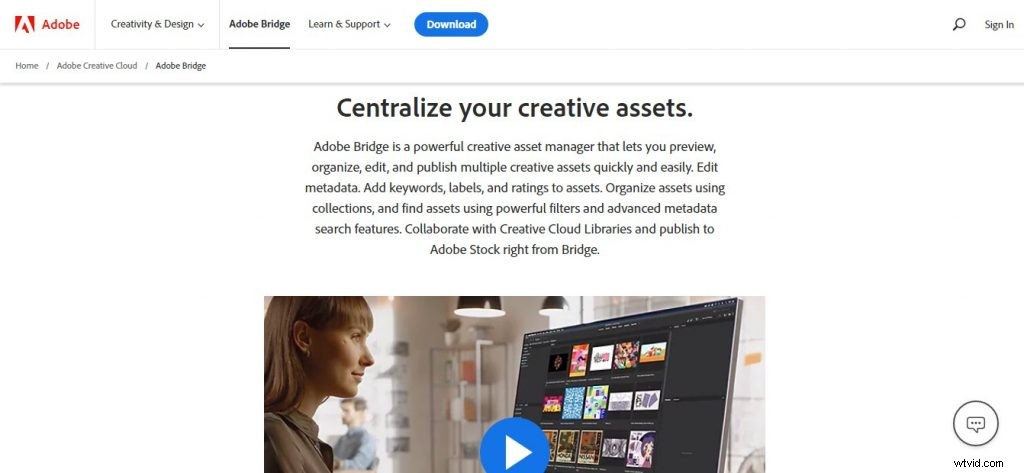
Adobe Bridge è uno strumento organizzativo, un gestore di risorse digitali e un browser di file. Ti consente di sfogliare e organizzare i file sul tuo computer, visualizzare in anteprima i file e visualizzarne i metadati, modificare commenti o categorie per più file contemporaneamente, creare raccolte di file (denominate Preferiti in Adobe Bridge) e rinominare in batch più file.
Adobe Bridge CC può essere avviato come applicazione autonoma o da qualsiasi altra applicazione Adobe Creative Cloud. Puoi utilizzare Adobe Bridge per trovare e aprire rapidamente i file archiviati sul tuo computer o rete locale.
Dal pannello File di Adobe Bridge, puoi sfogliare gli elementi archiviati su supporti rimovibili, come CD e DVD; sfoglia gli elementi su computer remoti montati localmente; sfoglia gli elementi condivisi su un server; e accedere agli elementi nei repository online Il menu File include comandi che consentono di aprire file in altre applicazioni.
Il menu Modifica include diversi comandi che consentono di applicare modifiche a più file contemporaneamente. Ad esempio, puoi utilizzare il comando Rinomina batch per rinominare più file selezionati utilizzando un modello di nome file personalizzato.
È possibile utilizzare il comando Modifica metadati per aggiungere o modificare i valori dei metadati per i file immagine selezionati. Puoi anche aggiungere immagini ai preferiti (chiamati Raccolte nelle versioni precedenti di Bridge) utilizzando il comando Aggiungi a raccolta.
Caratteristiche
Adobe Bridge è un browser di file che offre accesso centralizzato a tutte le risorse multimediali necessarie per i tuoi progetti creativi. Scorciatoie intuitive, opzioni di ordinamento e ricerca efficienti e layout personalizzabili semplificano la navigazione, l'organizzazione e la visualizzazione dei file.
È disponibile un'ampia varietà di versioni per diverse applicazioni. Funzionalità Adobe Bridge Accesso centralizzato alle risorse multimediali per flussi di lavoro di progetto semplificati Generazione di miniature e metadati per Adobe Creative Cloud Libraries, Adobe Stock e altre fonti Potenti funzionalità di elaborazione batch per file di immagine.
Pro
Adobe Bridge Pro Adobe Bridge è un potente strumento per i fotografi che desiderano gestire le proprie foto in modo rapido e semplice. È compatibile con Adobe Lightroom, Photoshop e molte altre popolari applicazioni di fotoritocco.
Il vantaggio dell'utilizzo di Adobe Bridge è che puoi utilizzarlo insieme ad altri prodotti Adobe o come applicazione autonoma. Ciò ti consente di modificare le tue foto con il tuo software preferito e quindi di catalogarle in Bridge.
Le caratteristiche principali di Adobe Bridge includono:
- La possibilità di ordinare le immagini per data, nome, metadati e decine di altre opzioni di ordinamento. Modalità a schermo intero che ti consente di visualizzare le tue immagini a colori e in dettaglio.
- Le anteprime delle immagini vengono generate automaticamente durante l'importazione delle immagini nel programma, così puoi vedere rapidamente le tue immagini senza doverle aprire singolarmente. Supporto per molti tipi di file diversi, inclusi RAW, JPEG, TIFF e altro.
3. Magix Photo Manager

Magix Photo Manager è il software di gestione delle foto perfetto per i principianti e per coloro che desiderano organizzare la propria raccolta di foto. Il software ti fornisce tutti gli strumenti necessari per ottimizzare le tue foto, correggere i difetti e apportare modifiche creative.
Magix Photo Manager è più di un semplice organizzatore di foto, tuttavia. È anche un editor di immagini di base, che ti consente di apportare semplici modifiche come ritagliare, ridimensionare e regolare la luminosità e il contrasto.
Ha impostazioni di correzione automatica che possono essere applicate con un solo clic. Il programma fornisce anche l'ottimizzazione con un clic per gli occhi rossi, il bilanciamento del colore e la nitidezza. Fornisce inoltre funzionalità di base per la creazione di presentazioni che ti consentono di creare presentazioni dalle tue foto.
Tuttavia, in questo programma mancano alcune funzionalità. Non fornisce strumenti di modifica avanzati, quindi se hai bisogno di qualcosa di più potente delle correzioni fotografiche automatizzate o delle semplici regolazioni, prova invece Magix Photo Editor.
Caratteristiche
Funzionalità di Magix Photo Manager Trova le tue foto e i tuoi video in pochi secondi. Trova rapidamente e facilmente tutte le tue foto, video e musica. La funzione di riconoscimento facciale intelligente trova i tuoi amici e la tua famiglia in un lampo.
Puoi anche utilizzare la funzione di filtro per data per individuare gli eventi o i viaggi che desideri rivivere in pochi clic. Modalità di visualizzazione Visualizza le tue foto in tutto il loro splendore a schermo intero o come una presentazione. La funzione di zoom ti consente di ottenere immagini più ravvicinate e personali, mentre la visualizzazione in miniatura ti consente di vedere più elementi della tua raccolta multimediale contemporaneamente.
Visualizzazione a schermo intero Visualizzazione zoom
Pro
Professionisti di Magix Photo Manager
- L'interfaccia utente è semplice e facile da usare, indipendentemente dal tuo livello di esperienza di fotoritocco. Anche come software di fotoritocco gratuito, ha alcune funzionalità avanzate che lo rendono più utile da usare rispetto ad altre opzioni gratuite.
- Include molti plug-in per un'ulteriore personalizzazione degli strumenti di editing disponibili nel programma. La funzione di ricerca funziona bene, quindi puoi trovare rapidamente le tue foto per nome o per categoria.
- È leggero e non consuma molte risorse quando è in esecuzione sul tuo computer, il che lo rende ideale per PC e laptop meno recenti
4. ACDVedi

ACDSee è un noto digital asset manager ed editor RAW. Ora alla versione 20, il programma è iniziato come shareware nel 1994 ed è stato aggiornato l'ultima volta nell'ottobre 2016.
La finestra principale di ACDSee 20 è suddivisa in cinque schede principali:Gestisci, Visualizza, Sviluppa, Modifica e Online. Ciascuna di queste schede apre una serie di menu e opzioni che consentono di eseguire le varie attività associate a ciascuna funzione.
Ad esempio, la scheda Gestisci consente di accedere a file e cartelle, creare backup, rinominare file e così via. Le schede Visualizza e Modifica sono simili alle funzioni che si trovano in qualsiasi programma di modifica delle immagini di base.
La scheda Sviluppo è dove puoi convertire le immagini RAW e apportare modifiche al bilanciamento del colore, alla curva dei toni e ad altre impostazioni della fotocamera. Il software di editing video ACDSee è uno strumento video completo per creare, modificare e condividere video.
Ti consente di convertire i video in qualsiasi formato, tagliare e ritagliare i video di cui hai bisogno. Puoi anche aggiungere filigrane, sottotitoli, filtri ed effetti per rendere i tuoi video più accattivanti.
Caratteristiche
ACDSee 20 è ricco di strumenti basati sull'efficienza per aiutarti a organizzare le tue foto, modificarle secondo necessità e ispirare i tuoi amici e la tua famiglia. Organizza la tua raccolta di foto in crescita senza perdere un momento.
ACDSee ha tutto il necessario per gestire, perfezionare e presentare le tue immagini. Esegui la gestione delle risorse digitali e tutte le attività essenziali del tuo flusso di lavoro fotografico in un'unica soluzione completa e incredibilmente veloce.
Visualizza le foto all'istante e lavora senza problemi con tutti i formati di immagine più diffusi. ACDSee 20 classifica automaticamente i tuoi scatti in base alle informazioni sui metadati (ad es. Parole chiave, dimensioni), consentendoti di trovare facilmente le immagini. Puoi persino sfogliare i file sul tuo computer guardando i raggruppamenti di date di acquisizione, valutazioni, etichette a colori o per cartelle Risparmia tempo con i comodi strumenti di modifica in batch
Pro
ACDSee è nel gioco del software di fotoritocco da più tempo rispetto alla maggior parte dei suoi concorrenti. Il suo software, ACDSee Pro, è ampiamente disponibile e molto apprezzato, ma non è il programma più facile da usare. I vantaggi di ACDSee sono:È ampiamente disponibile come versione di prova o per l'acquisto. ACDSee è noto per la sua velocità, che include sia la navigazione che l'elaborazione delle foto.
L'interfaccia è chiara e ben organizzata in schede. Ci sono molte opzioni per organizzare le tue foto. I contro di ACDSee sono:non è il programma più intuitivo da usare; avrai bisogno di un po' di tempo per sentirti a tuo agio.
5. Google Foto

Le migliori foto del Web Le foto scattate con il telefono vengono automaticamente salvate su Google Foto, organizzate e ricercabili. Puoi persino identificare persone, luoghi e cose specifiche che appaiono nelle tue immagini, così puoi trovarle velocemente.
Tutto ciò di cui hai bisogno per creare ricordi Che si tratti di un film di anni fa o di quelli che hai appena scattato, Google Foto ti consente di rivivere facilmente i tuoi momenti preferiti in qualsiasi momento. L'app suggerisce anche diversi modi per condividere in modo da poter creare più ricordi insieme.
Condividi con chiunque Condividere le foto è facile:assicurati solo che tutti abbiano l'app. Puoi persino condividere un intero album con un solo tocco. Spazio di archiviazione gratuito per tutta la vita Google Foto offre spazio di archiviazione illimitato per tutte le tue foto e i tuoi video in alta qualità, il che significa che sono leggermente compressi ma hanno comunque un bell'aspetto su qualsiasi dispositivo.
Se desideri archiviarli alle loro risoluzioni originali, utilizza invece Google Drive (che verrà conteggiato per lo spazio di archiviazione di Google Drive).
Caratteristiche
Google Foto è un ottimo strumento per gestire la tua raccolta di foto e renderla accessibile da qualsiasi dispositivo, ma è anche pieno zeppo di funzionalità che possono aiutarti a ottenere di più dai tuoi scatti. Ecco alcuni modi per utilizzare Google Foto a cui potresti non aver pensato.
Condividi album con utenti non Google In passato la condivisione degli album di Google Foto richiedeva un account Gmail, ma ora non più. Ora puoi condividere i tuoi album con chiunque utilizzi un link, indipendentemente dal fatto che disponga o meno di un account Google.
Basta fare clic sul pulsante Condividi in qualsiasi album e selezionare la casella "Ottieni collegamento". Otterrai un URL che puoi condividere come desideri. Modifica i tuoi scatti migliori Google Foto cura automaticamente le tue foto migliori in qualcosa chiamato "Schede assistente", a cui accedi facendo clic sul menu dell'hamburger nell'angolo in alto a sinistra dell'app.
La cosa interessante è che mentre lo fa automaticamente, puoi modificare queste carte prima che vengano condivise con amici o familiari. Basta fare clic su una scheda assistente per modificarla prima di condividerla con gli altri. Organizza la tua raccolta di foto in temi Una delle cose più utili di Google Foto è la sua capacità di ordinare la tua raccolta e identificare persone e oggetti.
Pro
Google Foto è un ottimo strumento per gestire la tua raccolta di foto e renderla accessibile da qualsiasi dispositivo, ma è anche pieno zeppo di funzionalità che possono aiutarti a ottenere di più dai tuoi scatti. Ecco alcuni modi per utilizzare Google Foto a cui potresti non aver pensato.
Condividi album con utenti non Google In passato la condivisione degli album di Google Foto richiedeva un account Gmail, ma ora non più. Ora puoi condividere i tuoi album con chiunque utilizzi un link, indipendentemente dal fatto che disponga o meno di un account Google.
Basta fare clic sul pulsante Condividi in qualsiasi album e selezionare la casella "Ottieni collegamento". Otterrai un URL che puoi condividere come desideri. Modifica i tuoi scatti migliori Google Foto cura automaticamente le tue foto migliori in qualcosa chiamato "Schede assistente", a cui accedi facendo clic sul menu dell'hamburger nell'angolo in alto a sinistra dell'app.
La cosa interessante è che mentre lo fa automaticamente, puoi modificare queste carte prima che vengano condivise con amici o familiari. Basta fare clic su una scheda assistente per modificarla prima di condividerla con altri.
Organizza la tua raccolta di foto in temi Una delle cose più utili di Google Foto è la sua capacità di ordinare la tua raccolta e identificare persone e oggetti in
6. digiKam
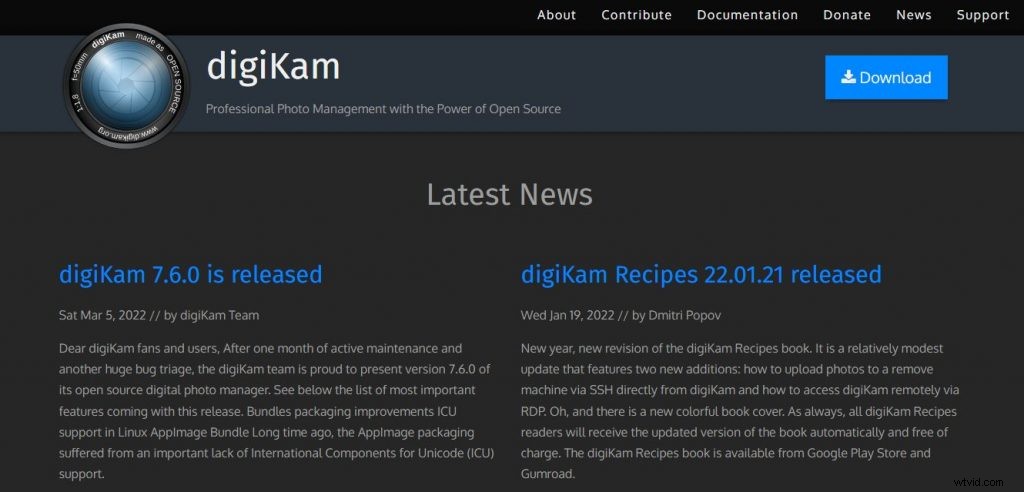
digiKam è il software di gestione delle foto digitali personali che ti aiuta a gestire le tue foto digitali. Quando avvii digiKam, ti presenta una finestra contenente tutti i tuoi album, ordinati per data o per nome.
Ci sono molte viste diverse tra cui scegliere. Il menu Visualizza contiene un elenco di diversi modi per visualizzare le immagini. Puoi visualizzarli come miniature, in una tabella, come immagini a dimensione intera, in un calendario e altro ancora. Puoi anche scegliere le informazioni da visualizzare sotto ogni immagine.
La barra degli strumenti contiene pulsanti che eseguono azioni comuni come l'importazione e l'esportazione di immagini, la creazione di miniature e molto altro. Il pannello principale mostra un'anteprima dell'immagine attualmente selezionata.
Ha anche cursori per regolare contrasto e luminosità, nonché strumenti per regolare nitidezza, saturazione e altro. digiKam farà del suo meglio per organizzare automaticamente i tuoi file quando li importi in digiKam. Tuttavia, se non riesce a capire le cose (o se le capisce in modo errato), puoi facilmente sistemare le cose usando il trascinamento della selezione.
Caratteristiche
digiKam è un'applicazione avanzata di gestione delle foto digitali per Linux, Windows e Mac-OSX. Le persone che creano digiKam mirano a fornire agli utenti strumenti per aiutarli a gestire le loro foto.
Gli utenti possono aggiungere tag, valutare immagini, importare da fotocamere e condividere foto sulle reti. digiKam consente inoltre agli utenti di organizzare e cercare tra le proprie foto. Caratteristiche di digiKam digiKam ha molte funzioni che lo rendono una scelta eccellente per la gestione delle foto. Ecco alcuni dei principali:
Le foto possono essere organizzate in base a metadati come data, valutazione, colore, ecc. È possibile aggiungere tag alle immagini per ordinarle e rendere più efficace la ricerca Le immagini possono essere classificate da una a cinque stelle C'è un editor di immagini integrato con supporto per Immagini a 16 bit Le immagini possono essere importate da fotocamere digitali o altri dispositivi utilizzando libgphoto2 o Media Transfer Protocol (MTP).
Pro
digiKam Pro digiKam ha molte funzioni e non c'è modo di trattarle tutte in questo libro. Ecco alcuni di quelli che ritengo importanti:* È gratuito, open source e con licenza GPL. Ciò significa che non hai nulla da perdere provandolo e puoi contribuire al progetto se ne hai voglia.
* È multipiattaforma, il che significa che funziona su sistemi operativi Linux, Windows e Mac OS X. * È progettato per essere un'applicazione di gestione delle foto piuttosto che una semplice applicazione di fotoritocco.
Ciò significa che i database relazionali vengono utilizzati per memorizzare i metadati sulle tue foto (come titolo, descrizione, data, posizione). La struttura dei file è meno importante rispetto ad altri programmi come GIMP perché digiKam organizza i file per te.
I tuoi file sono ancora archiviati dove li hai messi sul tuo computer, ma digiKam tiene traccia della cartella in cui si trovano per te. Puoi anche aggiungere tag o commenti alle tue immagini per trovarle più facilmente in un secondo momento.
* Ha il supporto integrato per condividere le tue foto online tramite servizi come Facebook, Flickr, Picasa, SmugMug e altri.
7. FastStone
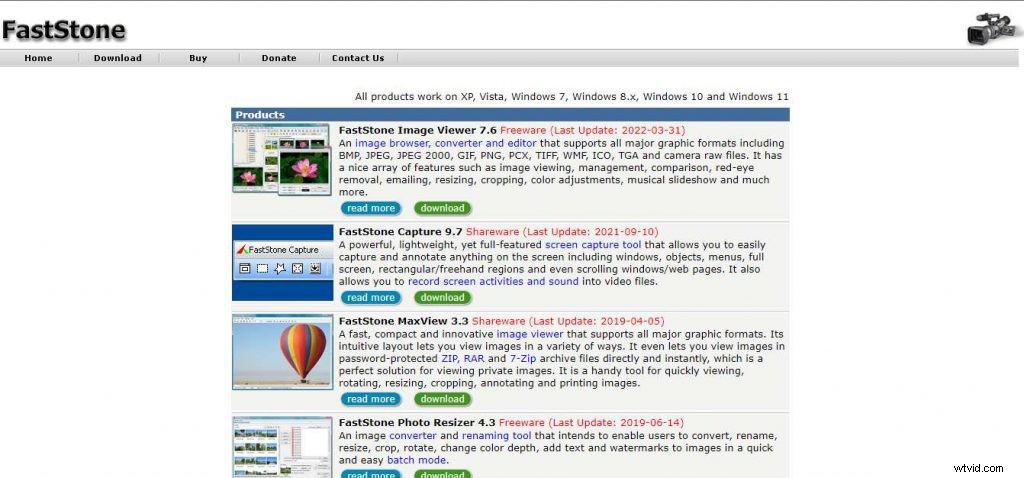
FastStone Image Viewer è un browser, convertitore ed editor di immagini veloce, stabile e facile da usare. L'applicazione ha una buona gamma di funzioni, che includono la visualizzazione delle immagini, la gestione, il confronto, la rimozione dell'effetto occhi rossi, l'invio di e-mail, il ridimensionamento, il ritaglio e le regolazioni del colore.
La sua modalità a schermo intero innovativa ma intuitiva fornisce un rapido accesso alle informazioni EXIF, al browser delle miniature e alle principali funzionalità tramite barre degli strumenti nascoste che si aprono quando il mouse tocca uno dei quattro bordi dello schermo. Altre caratteristiche includono una lente d'ingrandimento di alta qualità e una presentazione musicale con oltre 150 effetti di transizione, oltre a transizioni JPEG senza perdita di dati, effetti di ombreggiatura, annotazione dell'immagine, supporto per scanner, istogramma e molto altro.
Supporta tutti i principali formati grafici (BMP, JPEG, JPEG 2000, GIF animate, PNG, PCX, PSD, EPS, TIFF), i più diffusi formati RAW per fotocamere digitali (CRW/CR2/NEF/PEF/RAF/RAW/DNG/MDC/ MMR) e molti altri formati di immagine rari (calendario CMYK PSD).
Caratteristiche
Browser e visualizzatore di immagini con un'interfaccia utente familiare simile a Esplora risorse di Windows Supporto di molti formati di immagine popolari:BMP, JPEG, JPEG 2000, GIF, PNG, PCX, TIFF, WMF, ICO e TGA Visualizzatore a schermo intero reale con supporto per lo zoom dell'immagine ed esclusivo pannelli dei menu a comparsa Lente d'ingrandimento uno-a-uno personalizzabile e trasparente Potente gestione delle immagini, inclusa la funzionalità di tagging.
(che sostituisce la struttura delle cartelle convenzionale) e il supporto Copia in/Sposta in cartella.Un processore batch di immagini veloce e flessibile Associazione file, supporto drag&drop, ricerca file ricorsiva.
Pro
Pro FastStone Preparati a lasciarti sbalordire dalla nuova versione di FastStone. Lo sviluppatore del software continua a fornire una serie di aggiornamenti e questa volta ci ha portato alcune straordinarie funzionalità che miglioreranno la tua esperienza di editing.
Ecco alcune delle funzionalità che dovresti aspettarti nella nuova versione:– Ora puoi sincronizzare le impostazioni di più immagini con un solo clic. Ciò significa che non devi modificare ogni immagine una per una.
Scegli una foto e apporta le modifiche desiderate, quindi premi il pulsante Sincronizza e scegli le altre immagini che desideri regolare utilizzando le stesse impostazioni. – Gli sviluppatori hanno aggiunto più opzioni di editing per ottimizzare la curva del tono, inclusa la possibilità di passare da curve personalizzate, filmate e parametriche.
Sono state inoltre migliorate le funzionalità esistenti come la regolazione della profondità delle ombre, la compressione delle alte luci, il contrasto dei mezzitoni e i livelli di nero. – Gli utenti possono ora specificare quali plug-in vengono caricati all'avvio di FastStone. Ciò assicurerà che il tuo flusso di lavoro sia più fluido poiché non perderai tempo a installare plug-in per strumenti che non usi molto spesso.
8. Fototeca
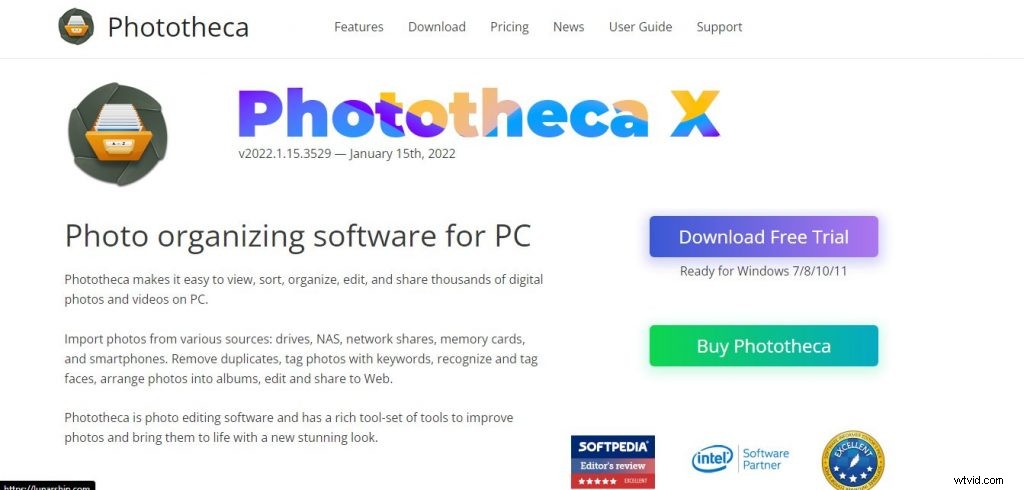
Quando si tratta di visualizzazione, modifica e gestione delle immagini con un budget limitato, FastStone Image Viewer è il miglior affare in circolazione. Ha tutto ciò di cui hai bisogno per visualizzare, modificare, gestire e convertire tutte le immagini sul tuo computer.
FastStone offre una vasta gamma di strumenti che spesso si trovano solo nelle app premium. Questi includono la rimozione dell'effetto occhi rossi, il ritaglio, il ridimensionamento, la rotazione JPEG senza perdita di dati e altro ancora. Puoi anche impostarlo come visualizzatore di immagini predefinito e configurare i tasti di scelta rapida a tuo piacimento.
L'ultima versione aggiunge anche il supporto per la scansione di documenti e immagini direttamente nell'app, molto utile se non si dispone di un'applicazione scanner dedicata. FastStone Image Viewer è il mio visualizzatore di immagini preferito da molti anni ormai. È veloce, leggero e funziona incredibilmente bene.
Questo sito è molto utile per il mio corso di fotoritocco. Ci sono molti articoli che possono essere utilizzati per aiutare un principiante con le basi del fotoritocco e alcuni suggerimenti avanzati. Il sito Web contiene anche molti articoli che discutono di diversi software che possono essere utilizzati per il fotoritocco, che possono aiutare le persone a trovare il software più adatto a loro.
Caratteristiche
Phototheca è un software per organizzare le foto che ti consente di organizzare le tue foto in pochi clic. Ecco alcune funzioni che Phototheca fornisce per aiutarti a gestire la tua raccolta di foto:Crea eventi, cartelle, album e album intelligenti Modifica i metadati in blocco Cerca le immagini per nome e tag.
Ordina le immagini per data, nome, valutazione e tag Valuta le immagini da una a cinque stelle Applica tag per una ricerca rapida Visualizza le foto come galleria o come miniature Visualizza le informazioni EXIF nella schermata di anteprima dell'immagine
Pro
Uso Phototheca Pro da alcune settimane ormai e sta rapidamente diventando il mio software di gestione delle foto di riferimento. Mi piace l'interfaccia, la facilità d'uso, è veloce e tutti i piccoli extra (come un visualizzatore di presentazioni integrato).
Mi piace anche che tu possa aggiungere tag alle foto e che siano salvati all'interno della foto stessa in modo che siano sempre lì, indipendentemente dal computer o dall'unità su cui si trovano. Se posso essere così audace, ho un paio di suggerimenti per migliorare:
* Sarebbe bello avere un'opzione per vedere l'intero database dei tag in una volta in modo da poter avere un'idea di quanti tag hai, quante foto ci sono in ogni tag e così via.* La possibilità di ordinare le foto per data di acquisizione o la data aggiunta sarebbe utile.
* Forse una modalità opzionale di "modifica rapida" con strumenti di modifica di base per regolazioni rapide senza dover aprire un'altra finestra (simile al modulo Sviluppo di Lightroom). Nel complesso, consiglio vivamente questo programma.
9. PicaJet

PicaJet è un organizzatore di immagini che ti consente di creare album fotografici online e condividerli con familiari e amici. Il programma ha un comodo set di strumenti per modificare le tue foto:ritaglia, ruota, ridimensiona, regola la luminosità, ecc.
Inoltre, PicaJet supporta la maggior parte dei formati RAW per fotocamere digitali (CRW, CR2, DNG, NEF, PEF, RAF), inclusi quelli più recenti come Canon CR2 e Nikon NEF. Puoi anche creare presentazioni con la musica della tua raccolta di foto. È facile stampare più immagini su una pagina e creare un album fotografico di alta qualità.
Puoi organizzare le tue foto assegnando parole chiave o utilizzando l'editor EXIF integrato per informazioni dettagliate sull'immagine (produttore della fotocamera, modello e tempo di esposizione). Il programma può assegnare automaticamente parole chiave da nomi di file o cartelle.
PicaJet supporta tutti i formati RAW più diffusi di Nikon (NEF), Canon (CRW), Pentax (PEF), Olympus (ORF), Sony (SR2), Panasonic (RAW), Minolta (MRW) e Fuji (RAF). Viene fornito anche il supporto per tutti i formati di immagine più diffusi come JPEG, TIFF e BMP.
Caratteristiche
Il modo migliore per valutare PicaJet è semplicemente scaricarlo e provarlo tu stesso. Di seguito sono riportate solo alcune funzionalità che troverai in PicaJet che rendono la gestione delle foto facile e divertente. PicaJet semplifica la gestione di migliaia di foto digitali.
La fotografia digitale ha permesso a chiunque di scattare molte foto, ma gestirle può essere un lavoro ingrato. Con l'interfaccia familiare, l'architettura aperta e il potente motore di database di foto di PicaJet, organizzare tutte le tue foto è facile come 1-2-3!
PicaJet organizza tutte le tue immagini automaticamente per data, tipo e nome della cartella. Puoi anche creare Categorie personalizzate, aggiungere parole chiave e valutazioni alle tue foto. Basta trascinare e rilasciare le foto direttamente dalla fotocamera o dal disco rigido negli album fotografici di PicaJet.
Puoi accedere a qualsiasi foto all'istante! Visualizza, modifica e stampa le tue foto con il visualizzatore di immagini integrato di PicaJet. PicaJet è il compagno perfetto per le fotocamere digitali!
Pro
PicaJet Pros I nostri utenti parlano:PicaJet è un ottimo prodotto. Lo uso da 6 mesi e si è comportato in modo sorprendente. Adoro l'interfaccia utente e l'affidabilità del software. Ho appena acquistato picajet e sono rimasto colpito dalla facilità d'uso.
ragazzi avete fatto un lavoro fantastico! grazie per aver creato un ottimo programma a un prezzo accessibile. sono agganciato! Volevo solo dire quanto mi piace usare PicaJet Photo Organizer, che software favoloso! Ne ho provati altri, ma questo è di gran lunga il migliore che ho usato e anche a un prezzo così ragionevole!
10. Movavi Photo Manager
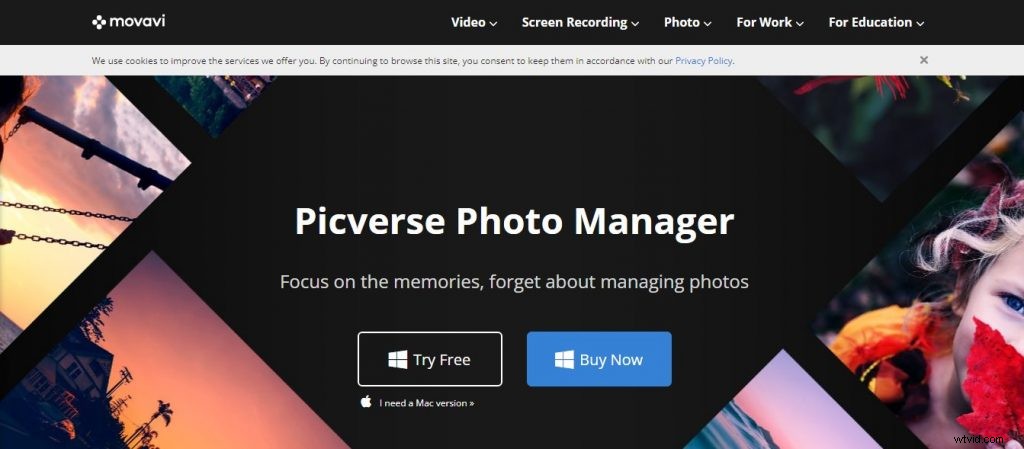
Photo Manager è un programma che ti permette di gestire le tue foto. È molto facile da usare e include tutti gli strumenti necessari per organizzare in modo efficiente la tua raccolta di foto.
Con Photo Manager, puoi facilmente mettere ordine nella tua libreria di foto creando album e spostando le foto al loro interno, nonché ordinandole per data. La funzione di ricerca integrata del programma ti aiuta a trovare qualsiasi immagine in un istante.
Photo Manager offre una gamma di opzioni di ottimizzazione per perfezionare la qualità delle tue immagini:aumentare la nitidezza delle foto sfocate, ritagliare, ruotare, livellare gli orizzonti, cambiare i colori e altro ancora! You can also quickly enhance the quality of any photo:just click Auto Fix in the toolbar!
With Photo Manager’s slideshow function, you can create impressive presentations of your best pictures. Just choose from one of the stylish ready-made templates and add music from our built-in audio library (or your own).
The program supports all popular image formats including TIFF, JPEG, BMP, GIF, PNG, RAW and more.
Caratteristiche
Movavi Photo Manager Features Ready to get a better photo organizer? Check out the Movavi Photo Manager features and advantages:Fast &Easy Organizing Quickly find any photo on your hard drive using unique tags and filters.
Find Duplicates &Similar Images Find duplicate and similar photos automatically, organize your photo collection, and delete the unnecessary copies Edit Photos Quickly &Easily Crop, flip, rotate and straighten images, adjust brightness and contrast, apply filters, and more!
Pro
Movavi Photo Manager Pros is a handy tool for organizing your image library. The application is compatible with most popular image formats and can be used to catalog images stored both on your computer and external media.
Movavi Photo Manager Pros lets you browse images by folder, date, rating, or tag. You can also use the search function to find photos using different parameters. The application allows you to view your photos in a slideshow, create screenshots, and convert images from one format to another.
Movavi Photo Manager Pros also offers tools for editing images:you can crop and rotate them, apply various effects and filters.
11. Zoner Photo Studio
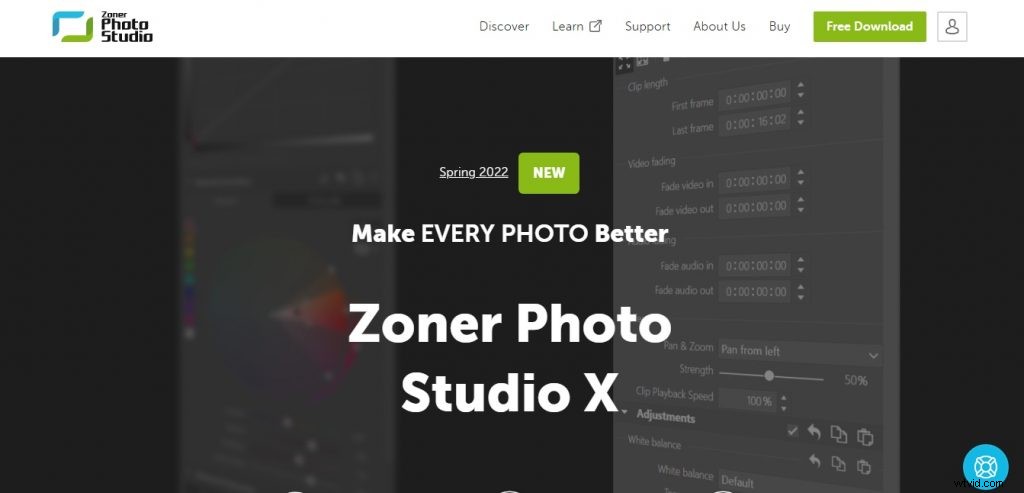
Caratteristiche
Working with photos from your camera, organizing them in a catalog, enhancing them and sharing them is all easy in Zoner Photo Studio. Save Time with Shortcuts Zoner Photo Studio offers you a complete workflow for every part of photo editing. So you can shorten your route to great photos.
Smart Catalogs and Improved Workflow The new Catalog system lets you manage all your photos without taking up too much space on your hard drive. You can even save searches as Smart Catalogs.
RAW Photos, HDR, Panoramas, and More From the RAW module to HDR and panoramas, Zoner Photo Studio has it all. And thanks to Time Machine, it’s always simple to return to previous versions of edited files.
Pro
Zoner Photo Studio X is the best Windows software for editing and organizing your photos. Download it and try it for free. Zoner Photo Studio X is the best Windows software for editing and organizing your photos. Download it and try it for free.
Main Features The Zoner Photo Studio Free edition offers you many of the basic functions including editing and organizing your photos. You can also try out its more advanced features, such as correction or HDR, completely free!
Zoner Photo Studio X is the best Windows software for editing and organizing your photos. Download it and try it for free. Top Reasons to Use Zoner Photo Studio 18 Pros Zoner Photo Studio X is the best Windows software for editing and organizing your photos. Download it and try it for free.
Photo Managemen Zoner Photo Studio 18 Pros offers a complete photo workflow from import to export, including:managing as you go, batch processing, geotagging, sharing on social networks, burning discs, backing up data to external drives, creating panoramas or 3D photos, etc..
What Is Photo Management Software?
Photo management software allows you to organize, edit, print and share digital photos. It can also act as a photo editing suite that includes basic to advanced features like color correction, exposure and red-eye removal.
Photo management software is useful for organizing images by date, subject or any other information you associate with the content of your photos. The software should allow you to group your photos in any way that makes sense to you so you can find them quickly at a later date.
Some photo management software programs allow for online backup of your images on the cloud, which ensures that if something happens to your computer, you won’t lose all of your pictures.
If you want to share photos on social media sites, such as Facebook or Twitter, photo management software can store and transfer images from a camera directly to the cloud via an internet connection. Many programs also let you create slideshows and upload them directly to social media sites.
What Should You Look For in Photo Management Software?
Managing your photos manually can be a hassle, especially if you want to share and access them across several devices. Photo management software can make it easier to organize, edit and share photos, but not all programs are created equal.
Here are the features to look for when selecting photo management software:The ability to import from multiple sources and devices. The ideal photo management software will allow you to import photos from anywhere, including digital cameras and smartphones (especially via Wi-Fi), as well as memory cards or USB drives.
Automatic organization. There’s no point in using photo management software if you’re going to have to spend time organizing your photos. Cloud-based systems that automatically sync with other devices are particularly useful because they allow you to access and share your photos without having to bother with transferring them yourself.
Most also automatically sort your photos by date or location and tag them with keywords so they’re easy to find later. Edit options. If you want more control over how your photos look, look for software that allows you to crop, rotate, create collages or add other effects (and undo those effects if necessary).
Some programs also offer automated editing options based on pre-set parameters like lighting conditions or the subject of the photo. Sharing capabilities
1. Artificial Intelligence in Photo Management Software
Computers are now capable of analyzing an image and understanding its content. Google’s deep learning artificial intelligence (AI) system has been able to identify and assign up to 3,000 different labels to a single picture. It can even distinguish between a banana and a hot dog!
Facial recognition software is not new, but the level of accuracy it can achieve has improved dramatically in recent years. Facebook can now recognize faces with 98 percent accuracy, more accurately than any human. Rekognition, Amazon’s facial recognition platform, is already used by law enforcement agencies across the United States.
If Big Data has given rise to Big Brother, then AI is taking it one step further. What was once only possible for governments with big budgets and unlimited time is now available to corporations at a fraction of the cost.
Companies such as Google and Facebook have been building their AI capabilities for years; they have vast amounts of data from billions of users and a virtually limitless source of computing power at their disposal.
But what does this all mean for photographers? How will our photo management software evolve in the future? And how will we benefit from advances in artificial intelligence?
2. Mobile App in Photo Management Software
Mobile App in Photo Management Software Photo management software is one of the most important things that every photographer needs. With it, he or she can enhance photos before sharing them with friends and family members.
But what makes a good photo management software? You should consider the following factors:The software should be able to work with different operating systems.
For example, it can work perfectly on your Windows PC and then on your iPhone. Some of the best software are those that are compatible with multiple platforms.
The program should come with built-in editing tools that allow you to crop, resize, rotate and change the color of your picture. It should also allow you to add special effects such as watermarks and text.
The photo management software should support both JPEG and TIFF formats so that you can save time when sharing your pictures with other people. TIFF files are usually much smaller than JPEGs but they’re not as popular because they require more space on your hard drive.
If you plan to share your photos online, you’ll want to use a program with built-in compression tools so they take up less disk space. It should give you an easy way to organize your images by date or by folder. This will help you find specific pictures
3. Search Capability in Photo Management Software
How well does your photo management software perform in a search? This is an important consideration because you can’t always remember the date or location of a photo. Also, you may have thousands of photos in your system, making it very time-consuming to browse them all.
So, top photo editing software allows you to search for images using descriptive tags. There are two types of tags:manual and automatic.
Manual tagging lets you enter keywords yourself. You can then use these keywords to find photos on your computer.
For example, if you want to find all photos that include your dog Spot, simply type “Spot” into the search field. The software will then display all images with the tag “Spot” in your results.
Automatic tagging uses artificial intelligence (AI) to label photos automatically. The AI likely analyzes the contents of the photo and assigns common tags based on that analysis. For example, if you upload a photo of a sunset at the beach, it could be assigned tags like “sunset” and “beach” automatically. Some AI is so clever that it can even recognize faces and assign their names as tags!
4. RAW Support in Photo Management Software
Do you ever feel overwhelmed by the number of photos you take and want a way to organize them in the best possible way? If so, then you’ve come to the right place! RAW files are an ideal format for sorting through your photos. They are an uncompressed, unprocessed file format that will allow you to make changes without altering the original file.
In this article, we’ll discuss what makes RAW files different from other common formats like JPEGs or PNGs! What is RAW support in photo management software? RAW support is a feature of photo management software that allows users to import photos in the RAW file format and make adjustments without changing the original image.
This enables photographers who shoot with DSLR cameras or mirrorless systems to have more control over their images before exporting them as JPEGs or other compressed formats for sharing online or printing out at home or at a professional lab.
The main advantage of using RAW support is that it gives photographers access to all data captured by their camera’s sensor when taking pictures in order to create higher quality images with less effort on post-processing work.”
5. Wireless Support in Photo Management Software
If you’re like me, you take a lot of pictures. And if you’re like me, you’ve had to deal with the hassle of transferring those pictures from your phone to your computer. It’s been a hassle for a long time, and it hasn’t gotten any easier.
Thankfully, there are some software options that attempt to streamline the process by offering wireless support in their photo management software What is Wireless Support in Photo Management Software?
Wireless support in photo management software allows you to transfer files seamlessly between devices without having to physically connect them together. Instead of having to use a cable or physically connect the two devices together, the photo management software does all the work for you without any physical connections required.
How Does Wireless Support Work?
The first thing that’s required is an Internet connection. You’ll need an active WiFi network or data connection in order to use this feature as it streams data across the Internet and uses cloud syncing technology.
Additionally, some pieces of photo management software require that both devices be on the same WiFi network in order to facilitate the transfer. Once both devices are connected and logged in, it’s just a matter of selecting which photos you want to transfer and where they should go.
Some pieces of software make this more If you’re like me, you take a lot of pictures. And if you’re like me, you’ve had to deal with the hassle of transferring those pictures from your phone to your computer. It’s been a hassle for a long time, and it hasn’t gotten any easier.
Thankfully, there are some software options that attempt to streamline the process by offering wireless support in their photo management software. What is Wireless Support in Photo Management Software? Wireless support in photo management software allows you to transfer files seamlessly between devices without having to physically connect them together.
Instead of having to use a cable or physically connect the two devices together, the photo management software does all the work for you without any physical connections required.
How Does Wireless Support Work?
The first thing that’s required is an Internet connection. You’ll need an active WiFi network or data connection in order to use this feature as it streams data across the Internet and uses cloud syncing technology.
Additionally, some pieces of photo management software require that both devices be on the same WiFi network in order to facilitate the transfer. Once both devices are connected and logged in, it’s just a matter of selecting which photos you want to transfer and where they should go. Some pieces of software make this more
6. Photo Editing Features in Photo Management Software
For an amateur photographer, the best solution for making photo editing is a photo management software. There are numerous programs that can help you to improve your photos and make them look professional.
It is possible to choose from a wide range of software products and decide on the one that meets your needs, both personal and professional. The available features vary from program to program.
One of the most important features in this type of software is editing. It consists in correcting certain imperfections that can be seen in pictures and adding different effects to achieve the desired result.
You can use the tools provided by these programs to adjust brightness, contrast, saturation and white balance, as well as add effects like borders and frames. Some of them also allow you to adjust other aspects of an image like color temperature or sharpness.*
How Do You Use Photo Management Software?
There are a number of ways you can use photo management software. The primary way is to organize your photos. With the right software, you’ll be able to sort your photos by any criteria that matters to you, including date, location, or subject.
You’ll also be able to search for specific photos by name or description, so you need never lose track of a treasured picture again. You can also use photo management software to edit and retouch your photos.
Some programs allow you to crop and resize photos, as well as adjust the color and brightness to produce the perfect image. Many applications even allow you to add text or draw on your pictures.
If you’re looking for a simple way to share your photographs with friends and family, photo management software makes it easy. The best programs allow you to easily upload images from your computer directly onto the Internet for others to view.
Many programs also have built-in features that let you email pictures without having to leave the application. Other useful features include options for printing images on photo paper in various sizes, as well as creating slideshows or digital albums of your favorite pictures.
Photo management software may even include templates that let you create greeting cards, calendars and other customized items featuring your favorite photographs.
Tips For Using Photo Management Software?
Are you a budding photographer? If so, you probably have hundreds of pictures saved on your computer or camera. With the right photo management software, you can organize them in a way that makes it much easier to find the ones that you need. Here are some tips for using photo management software:
Find Software That Works With Your Current Picture Files One of the first things that you need to do is find software that will work with your current picture files. There are many different image file types, and not all software will be compatible with everything.
You don’t want to run into issues where you can’t open or view your pictures because they’re saved in a format that isn’t supported by your software! Choose Software That Is Easy To Use Your photo management software should be easy to use if you want to get the most out of it.
When you have hundreds of pictures on your computer, you don’t want to spend hours trying to sort through them and organize them; you want to be able to pull up what you need quickly. Look for software programs that offer simple navigation and easy-to-understand controls so that you can use your program without any issues. Look For Software That Offers A Range Of Organization Options You should also look for
1. Using Photo Management Software Get The Settings Right
Photo Management Software is a program that helps you organize, edit and share your digital images. There are various types of software to help you in the image editing process. Some are free, such as Picasa, GIMP and Paint.NET, while others require you to purchase them.
Examples of photo management software include ACDSee, Adobe Photoshop Elements, Apple iPhoto and Google Picasa. These programs come with different features and price ranges.
Here’s a look at the basic functions of photo management software:Organizing:All programs can help you manage your photos by organizing them into albums or folders so they’re easier to find later on. Most also allow you to assign keywords or captions that make it easy to locate a specific image without actually having to view it first.
Viewing:The software lets you view your photos in different ways including thumbnails (small pictures) that represent entire albums of images, slideshows and single pictures up close. Some programs even have special features like panning across an image so it looks like you’re moving through an actual scene instead just looking at one still picture after another! This can be helpful for viewing large groups of photos at once without having to click through each individual image file individually.]
2. Using Photo Management Software Edit Photos
If you’re a serious photographer, you need to have at least one photo management tool in your arsenal. Photo management software is not just for sorting through and organizing your digital photos, but it can also help you with advanced tasks such as correcting flaws, adjusting exposure, removing red eye and resizing your photos before uploading them to the Web.
Some of the best photo management software will also allow you to create slideshows and even burn those images onto CDs or DVDs. Whether you want to catalog your photos for easy access or touch them up for a better look, photo management software makes photo organization a snap.
Photo Management Software:What to Look For When shopping for photo-management tools, consider what type of features are important to you. For example, if you have a large collection of images that needs organizing, look at the organizational capabilities of each tool.
If your photos need some touch-ups before they can be shared online or printed off, find out if the tool has the editing capabilities you need.
3. Using Photo Management Software Get your naming convention right
You’re going to want to do some housekeeping, organizing and culling as you go along. And it’s much easier to do this if your files are named logically from the start. I like to include the date at the beginning of a file name because it automatically sorts my images in chronological order, regardless of whether I downloaded them directly from my camera or had them sitting on a memory card for months before I got around to downloading.
The format I use is to have the year first, followed by the month and day (in numerical format), and then whatever descriptive name I’ve given my shoot. So an image file name might look something like this:2010-12-17 – New York City Street Photos – Image 0123
4. Using Photo Management Software Use folders and sub-folders
Use folders and sub-folder Even the best photo management software will fail if you don’t use it properly. The first step to managing your photos effectively is to build a folder structure that works for you.
What you name your folders is up to you, but I like to use a combination of years, locations, and event names. For example, let’s say I’m going on vacation to Los Angeles. I might create a folder named “2013 Vacation” inside which I create folders for each day of the trip — “Day 1,” “Day 2,” etc.
Within each of those folders, I might create another set of sub-folders for different types of photos — “landscape,” “food,” or “people” are common categories. By keeping my photos organized in this way from the get-go, they’re much easier to sort through later.
5. Using Photo Management Software Be creative with tags
Using Photo Management Software Be creative with tags When you’re managing a large digital photo collection, you need to use tagging tools to organize your images. Most good photo management software will have tag tools — and many other powerful features to help you organize your photos.
When you’re tagging photos, think of different ways you can use those tags to find the photos later on when you need them. Use multiple tags for each photo if it makes sense. For example, if you took a photo of a lake in Canada, you might want to tag it with “lake”, “Canada”, and “travel”, among others.
Once you’ve tagged your photos, using search tools, it’s easy to find what you’re looking for. For example, if you want to find all the photos from your trip to Canada, just search for “Canada”. Or if you want to find all the photos of lakes that you took on that trip or any other time, just search for “lake”.
Using Photo Management Software Be creative with tags When you’re managing a large digital photo collection, you need to use tagging tools to organize your images. Most good photo management software will have tag tools — and many other powerful features to help you organize your photos.
When you’re tagging photos, think of different ways you can use those tags to find the photos later on when you need them. Use multiple tags for each photo if it makes sense. For example, if you took a photo of a lake in Canada, you might want to tag it with “lake”, “Canada”, and “travel”, among others.
Once you’ve tagged your photos, using search tools, it’s easy to find what you’re looking for. For example, if you want to find all the photos from your trip to Canada, just search for “Canada”. Or if you want to find all the photos of lakes that you took on that trip or any other time, just search for “lake”.
6. Using Photo Management Software Search Photos
With photo management software, you can easily organize and manage your photos without spending a lot of time. In this post, I’ll show how to use such software to find the photos you want quickly.
Photo management software allows you to add tags and keywords to your photos so that you can search for them easily. The program will then make the search result into a list. This helps you find the pictures with ease because it saves you from scrolling through hundreds of files.
Here is an example:The program shows you a list of every picture in which people are smiling, as well as their location. You can then drill down to find the exact picture you are looking for by going through each item in the list one at a time.
You can also click on the image icon to see a preview of the picture in another window. This lets you compare the different images side by side and narrow down your search results even further.
This makes finding those perfect family vacation photos or last year’s Halloween pictures simple and easy!
-
Photo Management Software Frequently Asked Questions
- Whether you’re a professional photographer or just someone who takes lots of photos, managing and editing your digital images can be a challenge. There are many programs out there that can help you manage and edit your pictures.
- Here are some frequently asked questions about photo-management software:What is photo management software? Photo management software helps you organize, sort and find the digital photos stored on your computer.
- Many programs can also help correct minor flaws in photos, such as red-eye, cropping and lighting issues. Some programs allow you to write notes about the pictures, which can be handy if you’re using them for a business purpose, such as client proofs.
- What types of photo management software are there? There are many different programs available. You’ll want to consider how much photo editing capability you need, how easy it is to use and how much it costs before making a purchasing decision.
- Some of the most popular photo-management programs include Picasa, Adobe Lightroom and Aperture by Apple. They all offer at least some editing capabilities and make it easy to share your photos with friends and family via the Internet.
- How do I get started with photo management software? Once you’ve purchased a program, installing it is fairly simple. The program will help
What’s the best photo management software for PC?
Photos are one of our most precious and irreplaceable possessions. As such, it’s important to ensure that you back them up to a reliable service or piece of software. A photo management program is the best way to do this, but which one should you choose?
We’ve compared two of the most popular options on the market — Adobe Lightroom and Google Photos — to help you decide which is right for you. Which one is better:Lightroom or Google Photos? Lightroom is a much more powerful piece of software than Google Photos.
It’s fuller-featured and will give you much more control over your photos. However, it also comes at a cost. Lightroom costs $10 per month as part of Adobe’s Creative Cloud Photography plan and requires a monthly subscription to use.
Google Photos is completely free to use, although it does have some limitations in terms of what type of photos it can store without sacrificing quality. If you need a robust photo management tool that gives you complete control, then Lightroom is the way to go.
But if you just want somewhere safe to back up your photos that won’t eat into your storage space, Google Photos will do just fine.
What’s the best photo management software for Mac?
The best photo management software for Mac is Adobe Lightroom. It’s a comprehensive package that includes everything you need to manage, edit, and share your photos. Its powerful tools allow you to do everything from basic tweaks to advanced edits.
If you’re looking for the best photo management software for Mac, Adobe Lightroom is a great choice. Adobe Lightroom is a one-stop shop for all things related to digital photography.
It has an extensive list of features that make it a great tool for both professional and amateur photographers alike. The app is available on both desktop and mobile devices, so it’s easy to take your photos with you wherever you go.
One thing that sets this app apart from others is its ability to sync with Adobe Creative Cloud and other services like Dropbox or Box. This means that your photographs will always be up-to-date with any changes made on other devices or platforms.
Lightroom isn’t just software; it’s also an ecosystem of apps and services that will help you get the most out of your pictures. You can use the built-in editing tools to adjust colors, exposure, contrast, highlights and shadows in any image file type such as JPEGs or RAW files from DSLRs
Is There Free Photo Management Software Out There?
With so many free options, you may be wondering why you should pay for photo management software. The answer is simple:Because you get what you pay for. Free options may not offer the performance or advanced tools that can help you manage and organize your photos.
Free apps are also often limited in how many pictures you can upload and store. In contrast, paid photo management software gives you a full range of options that make it easy to manage your pictures.
Paid apps let you upload as many photos as you want and also offer useful features like automated backup and sync, facial recognition technology, GPS mapping, photo editing and sharing tools and more. The best part is that many paid photo management apps start at less than $5 per month — less than most people spend on lunch!
Why should I pay for photo management software?
With so many free options, you may be wondering why you should pay for photo management software. The answer is simple:Because you get what you pay for. Free options may not offer the performance or advanced tools that can help you manage and organize your photos.
Free apps are also often limited in how many pictures you can upload and store. In contrast, paid photo management software gives you a full range of options that make it easy to manage your pictures.
Paid apps let you upload as many photos as you want and also offer useful features like automated backup and sync, facial recognition technology, GPS mapping, photo editing and sharing tools and more. The best part is that many paid photo management apps start at less than $5 per month — less than most people spend on lunch!
Is open-source photo management software good?
Photography is an art, and as with all arts, a good photographer will try to find the best medium to express themselves. While some photographers will choose to use digital cameras, others may prefer the look of film.
Regardless of what your personal preference is, you’ll need a good photo management software to keep your photos organized and safe. The more professional photographers out there know that Adobe Lightroom is a must-have for editing photos, but when it comes to keeping your photos organized on your computer, there’s no substitute for open-source photo management software.
Open source photo management software like Shotwell offers you the ability to organize your photos into virtual folders and albums by tags, dates or any other method you can think of. You can also create slideshows or export photos in various formats including JPEG and TIFF files. Another great feature of open source photo management software is that it’s free! You won’t have to spend hundreds of dollars on expensive commercial software.
If you’ve been struggling with organizing your photos because they’re scattered all over your hard drive in various folders, then check out open source photo management software like Shotwell today!
Best Photo Management Software – Wrapping Up
As you can see, there are a lot of options for photo management software out there. While most will get the job done, some programs definitely stand out from the crowd. If your goal is merely to organize your pictures, then any of the programs I reviewed in this article will do just fine.
However, if you’re looking for something that can edit photos, or even create works of art out of them, then you’ll have to search further afield. For instance, I know GIMP is a powerful image-editing program but it is a bit too complex for my needs.
I like simple and straightforward programs that don’t take up too much space on my computer! If you liked this article, please share it on Facebook so others can learn about photo management software as well!
There you have it, the top five photo management software programs. Hopefully you now understand their features and how they can help you. Now that you’re armed with this information, which program will you choose? Fatecelo sapere nei commenti qui sotto!
